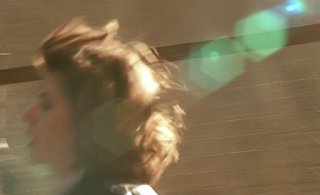Yet Kieslowski also had a great sense of camera movement and editing. With carefully calculated camera movement and precise editing, a scene that could be boring, a bridge to get from one place to another, becomes invigorating cinema on its own. In this case, there's a moment early in the film when Weronika spends the night with her boyfriend and then in the early morning has to rush off to school. Let's take a look at how Kieslowski takes what could have been a simple bridge moment and makes it interesting.
We start with medium still shot of Weronika running around a curved street
As she goes around the bend, the camera moves with her as she goes up these steps
She turns right and so does the camera, as we now follow her through railing and vines running alongside a building
We could see her face at first, but now it's cut out of the frame as the camera begins to move downward with the action
It continues its decline, cutting off more of Weronika
And more...
And more...
And now we find out why. There's a puddle, and Kieslowski wants use to really hear the splash
And see it
This then prompts an abrupt cut to a closeup of Weronika running
As the sun fills the screen, Weronika is rendered almost invisible. It all happens in a flash, but the juxtaposition of the puddle and splash to this dazzlingly bright close up provides a jolt for the viewer. But there's also a nice correlation because the splash of the puddle prompts a cut that splashes the screen with sunlight. Because she's running we can guess Weonika is late for school, and so we can speculate Kieslowski wants to give a sense of palpability to that urgency.
Before we know it the split-second burst of light is gone
and the camera slows down and lets Weonika run away from it. End of scene
How could this have been boring? We see it all the time in movies. That shot of something in motion with the camera placed in front of it, and as it goes past the camera does a neat pan and watches it move away from it. Kieslowski simply made a few decisions to change this, and while it may have taken a bit more time, the viewer notices it, and more importantly, in this case, feels it.
All of this is simply to say that for filmmakers, think about how you can take a simple moment like this and employ smart camera movement and editing to make your film more interesting.
And for viewers, look for things like this that are strange or unusual and ask yourself: why? Good directors fill there movies with moments like this from The Double Life of Veronique, and so often they go unnoticed. Always try to notice more.













No comments:
Post a Comment